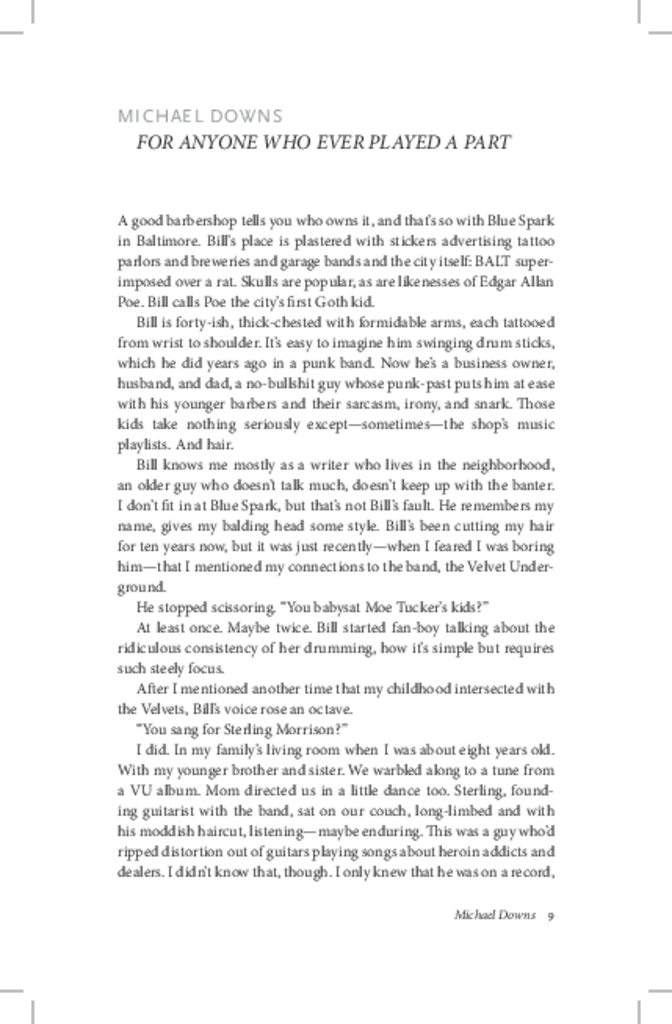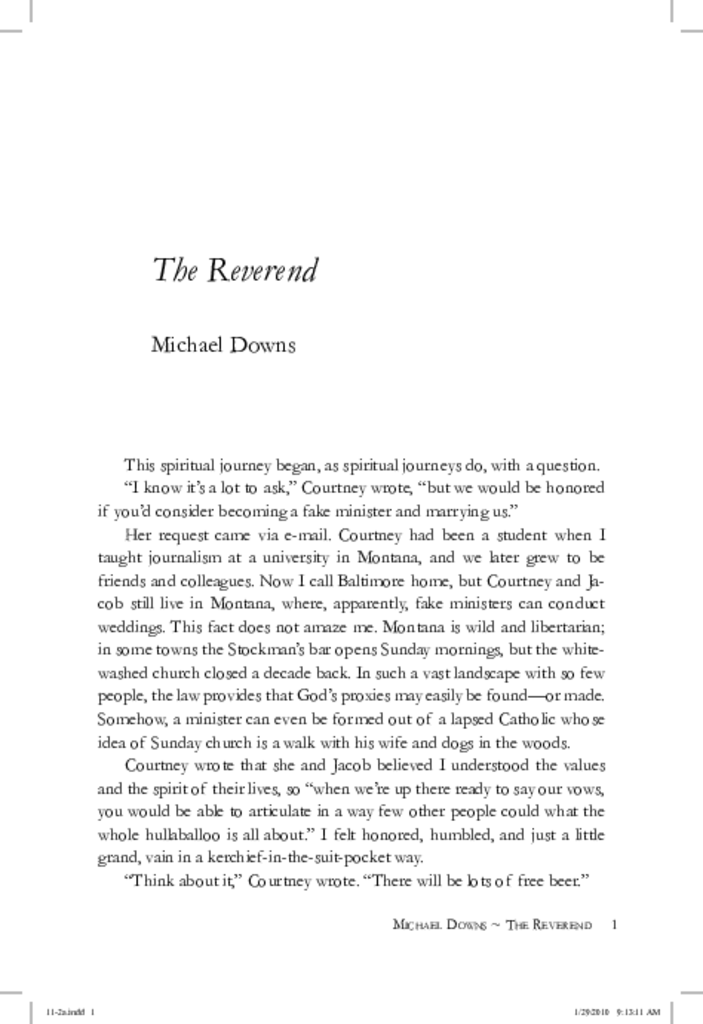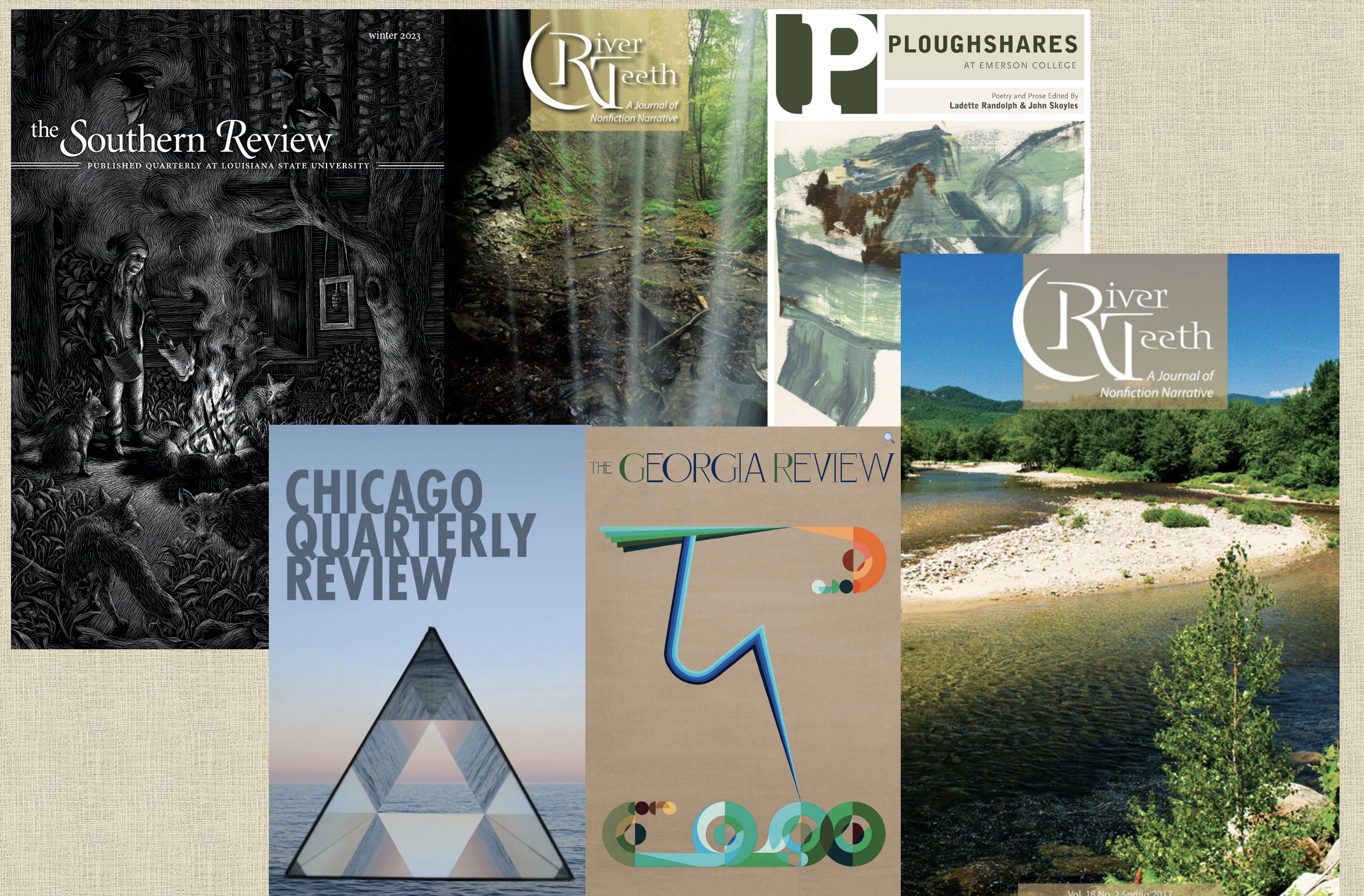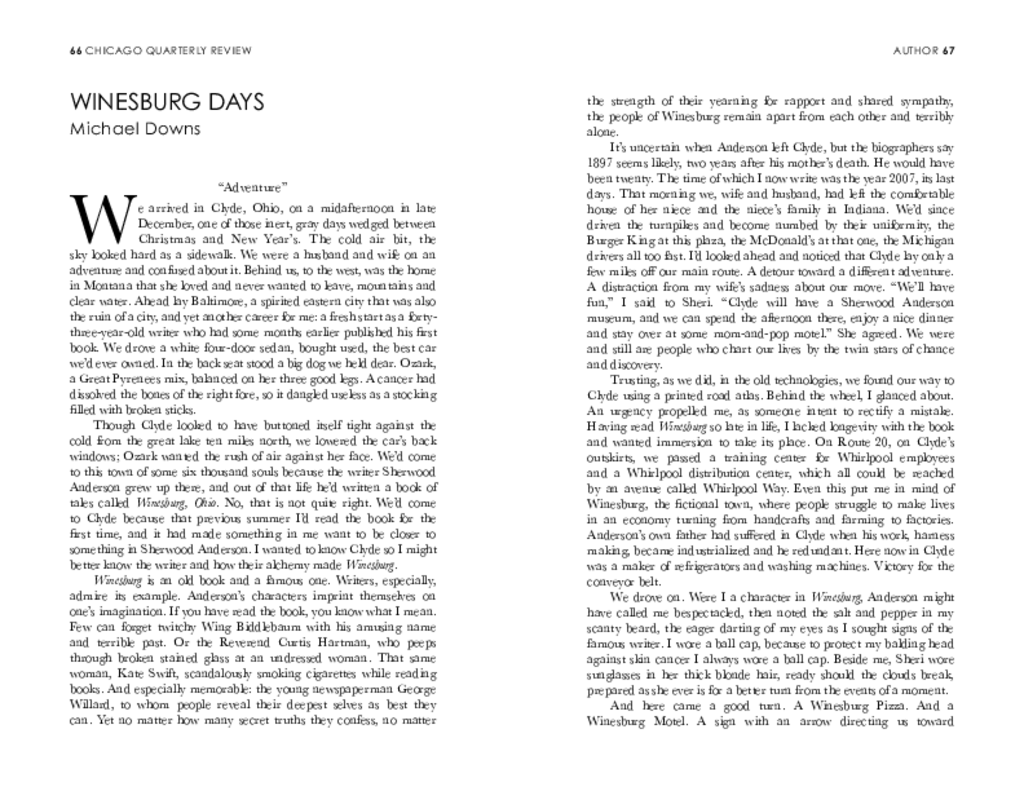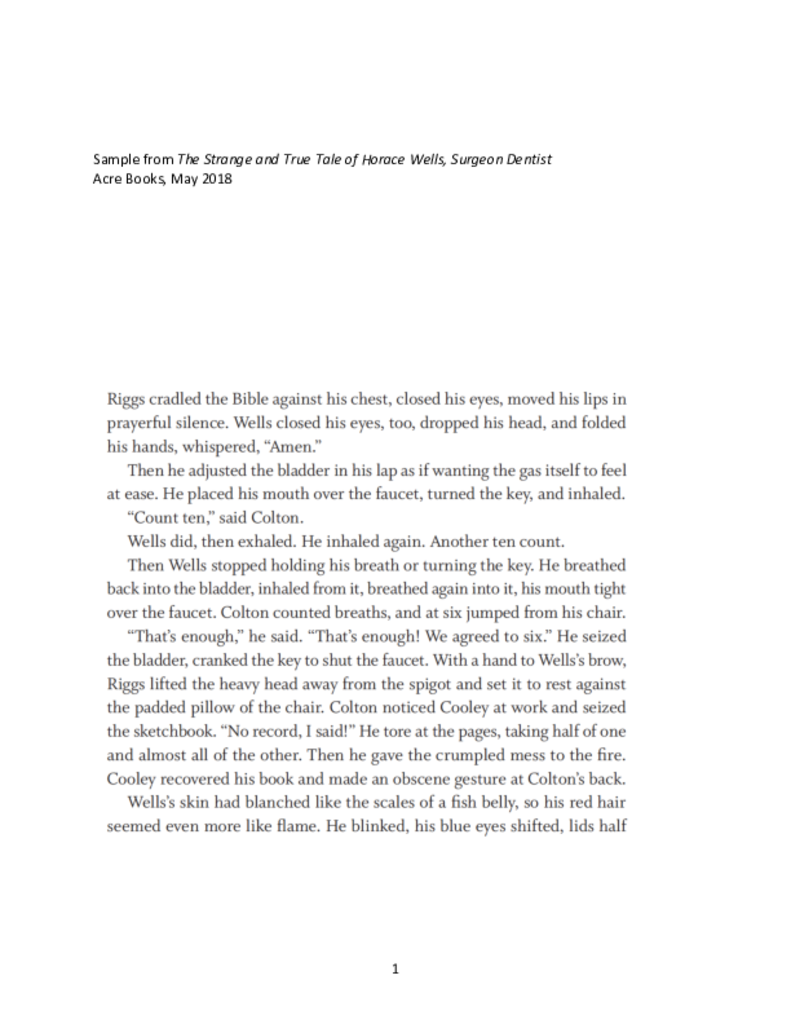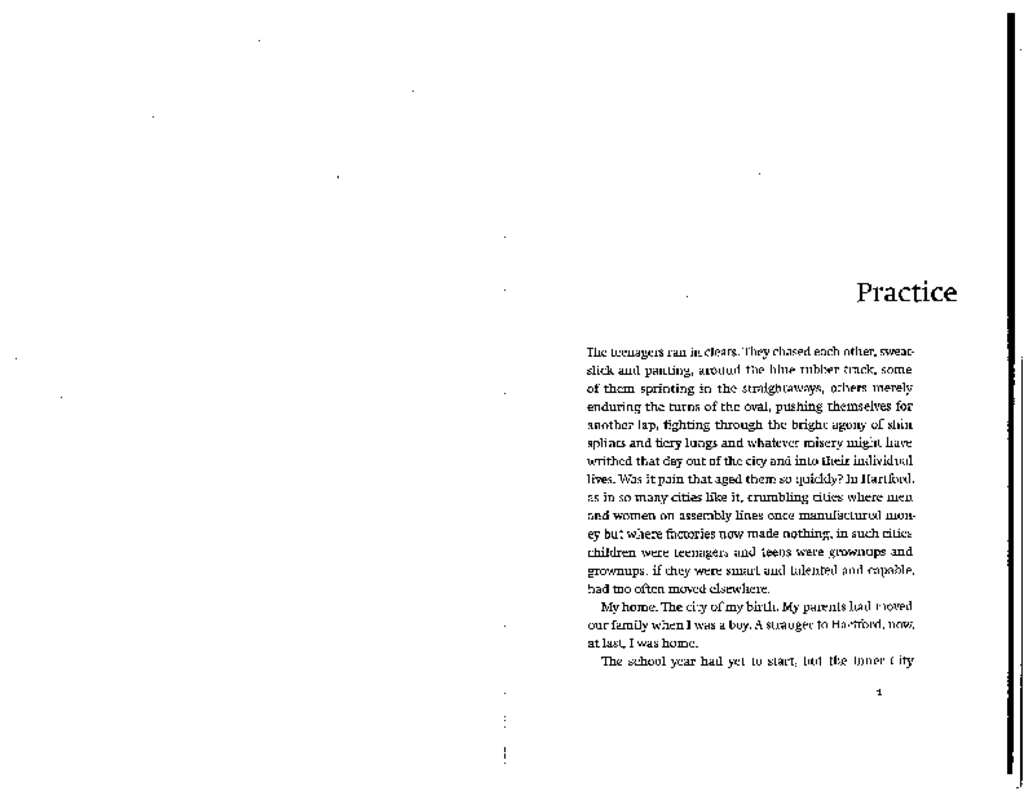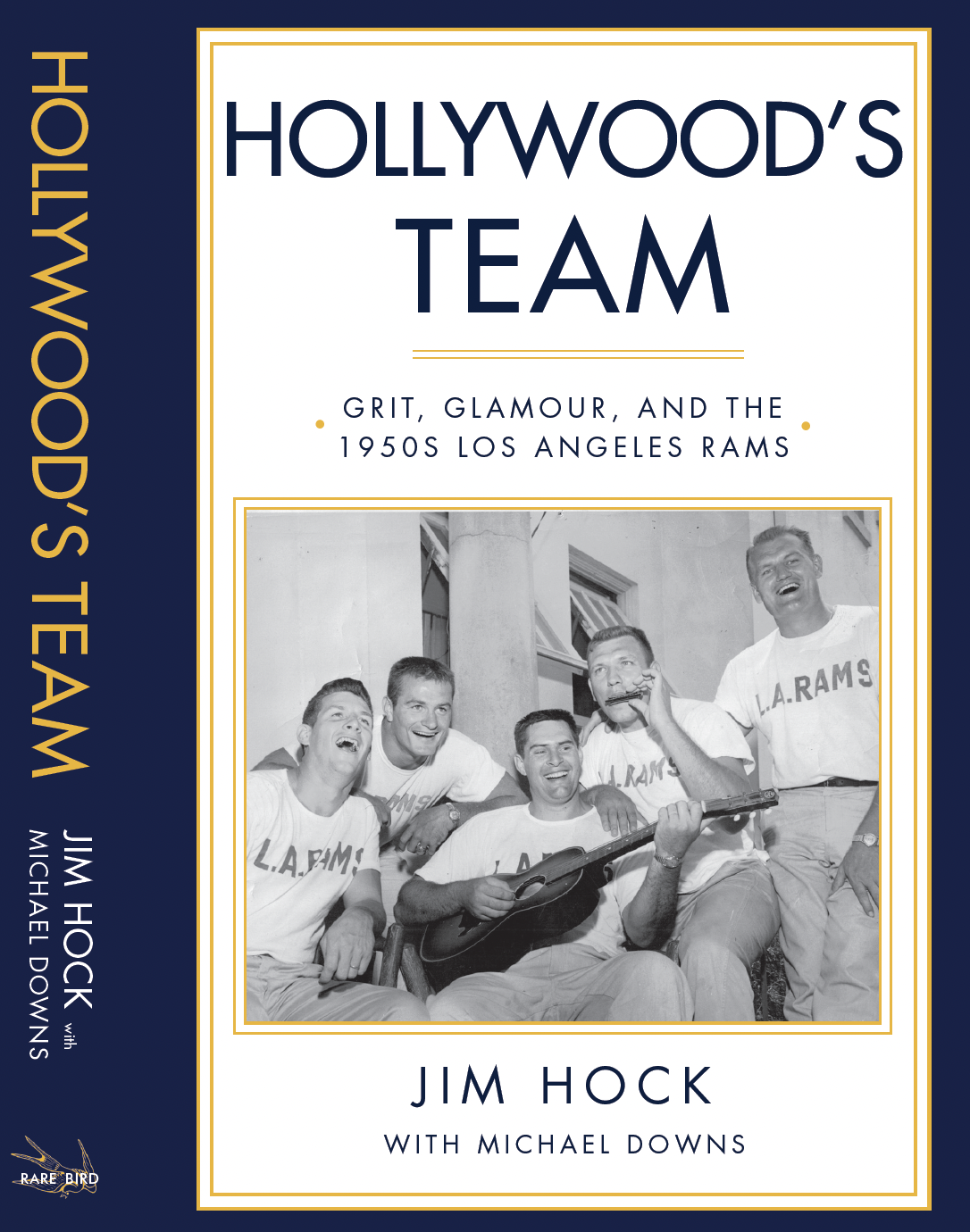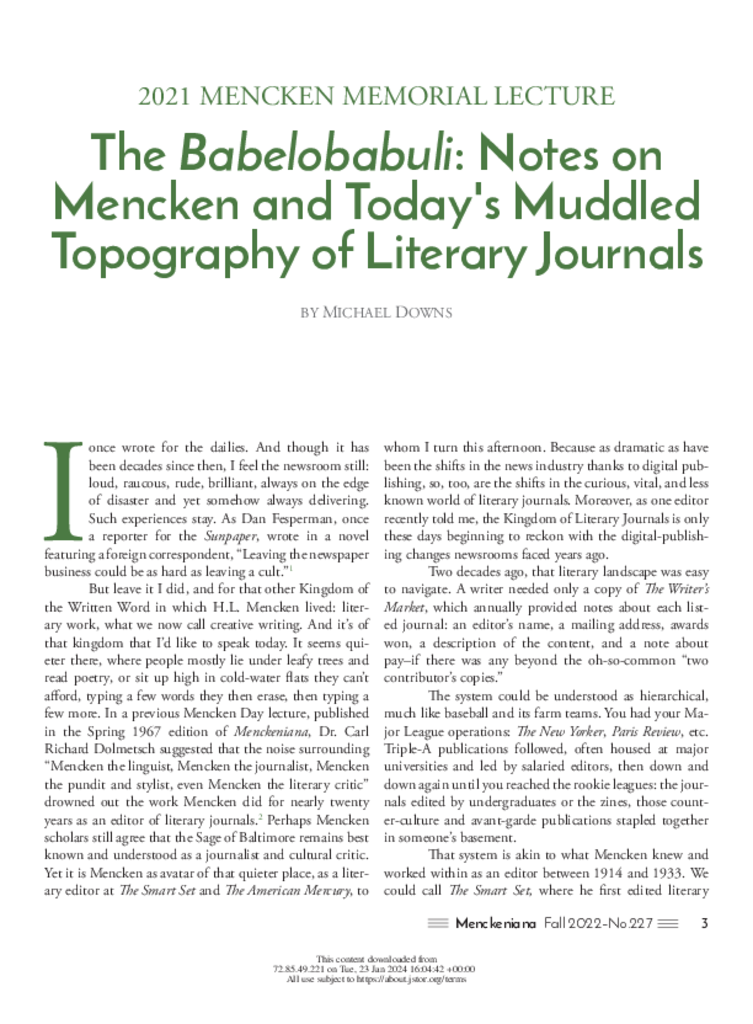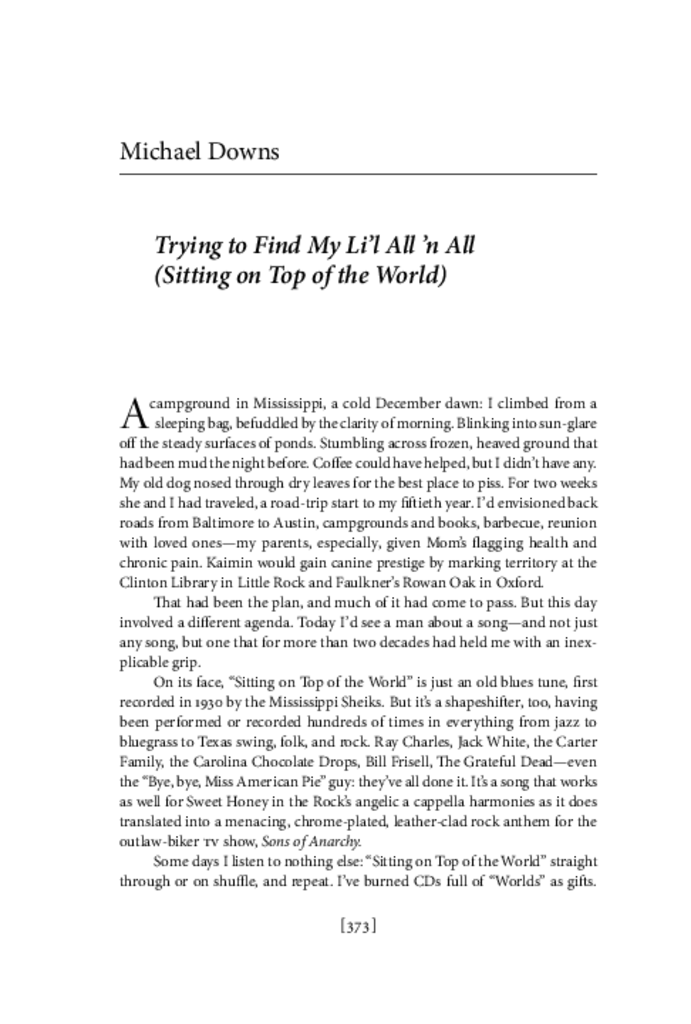Work samples
-
answer excerpt baker.pdf
That time when a member of the Velvet Underground talked me down from my horror after I'd read Lord of the Flies.
The morning when federal agents parked unmarked SUVs on my Baltimore street and took away my neighbor.
How serving as officiant at a friend's wedding caused me to dive deeply into my own ideas about God.
How visiting Clyde, Ohio, the boyhood home of famous author Sherwood Anderson, taught me about the conflicts between expectation and reality.
These and other literary nonfiction essays make up the starting point of a memoir-in-essays, with the working title "Answer When You Can." That title comes from an essay, published in The Southern Review in January 2023 and later winner of the Oran Robert Perry Burke Prize, in which I chase the origin of a letter never meant for me that nonetheless came into my life and changed it. That essay's opening appears in the image above. I invite you to click on it to read an excerpt.
-
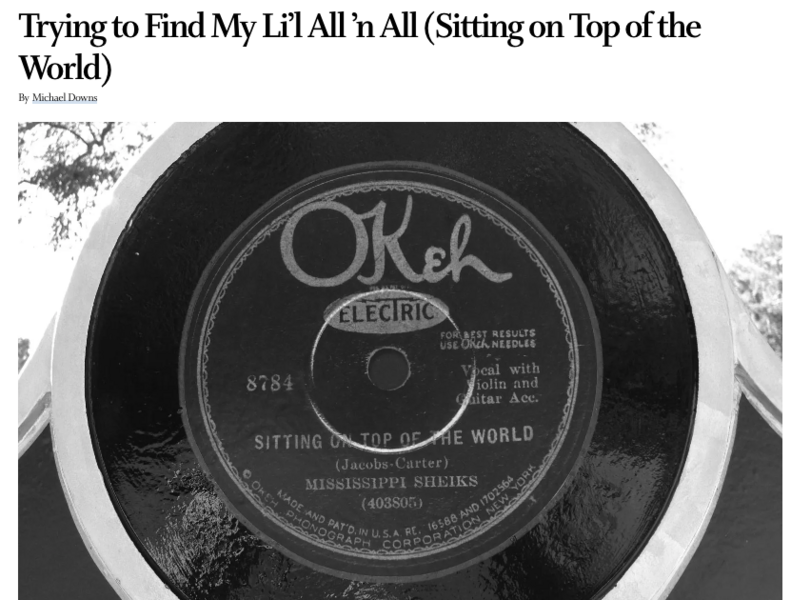 Now She's Gone, I Don't Worry: a song biography of "Sitting on Top of the World"
Now She's Gone, I Don't Worry: a song biography of "Sitting on Top of the World""What kind of song is that?" asked Lonnie Chatmon, fiddler for the Mississippi Sheiks, that moment in 1929 after his partner, Walter Vinson, played him a tune he'd just written.
One answer? “Sitting on Top of the World,” first recorded in 1930 by the Sheiks, is a shapeshifter, having been performed or recorded hundreds of times in everything from jazz to bluegrass to Texas swing, folk, and rock and gospel. In that way it's a deeply American song, one that migrates across genres, regions, and race, and meaning.What kind of song? One that for decades has held me with an inexplicable grip. One that led me to a literary memoir-essay in The Georgia Review, which in turn led me to my newest and ongoing book project: to write a song biography and tell the tale of this amazing, transcendent work of American art.
To read the essay, please see "Now She's Gone, I Don't Worry" under projects. -
YesterdayYears: short stories based on Polish legends
The Dragon under Wawel Castle; the dwarves of the Orange Revolution; pigeons who were once medieval knights; the gagged woman who haunted a king; Wojtek the Bear who fought the Axis ...
For 10 months as a Fulbright scholar in Kraków, Poland, I studied that ancient country's legends. What I wanted was to quiet the noise of the contemporary American literary scene and remind myself about primeval, essential aspects of storytelling. Our common culture's older stories–Greek myths, Biblical tales, Wild West legends–had become too familiar to shake up my understanding of fiction. But these distinctly Polish legends were new to me. This defamiliarization, combined with intense cultural study in one of the world's most literary cities, has led me to a whole new fiction-writing approach.
-
 Isn't It Fun How We Shine: A podcast of flash nonfiction
Isn't It Fun How We Shine: A podcast of flash nonfictionISN'T IT FUN HOW WE SHINE is a podcast about a neighborhood in Baltimore City's Westfield area during the Great Recession. Written as bits of flash nonfiction and interspersed with interviews and behind-the-scenes reveals, the podcast will chronicle the struggles of neighbors during an international crisis they can't control. Tender and often funny, these vignettes shape several narratives as people work to keep their neighborhood intact. A woman will go door-to-door asking for loans to pay her mortgage. A fellow with a chronic illness will give his house back to the bank. But also a man will break in through a second-floor window to rescue a dead neighbor's trapped cats. And a retiree will make a memorable cameo doing the hokey-pokey in a John Waters film.
Excerpts of the podcast's writing have been published in a variety of literary journals and been recognized as notable in Best American Essays. I invite you to visit "Isn't It Fun How We Shine" under projects to read examples of the flash nonfiction and to listen to audio.
The manuscript takes its title from graffiti spray-painted on a neighborhood dumpster: "Do Not Stop / Isn't it Fun How We Shine." The podcast is currently in production, made in collaboration with Dr. Jeremy Wexler, a musician and composer. The project began with assistance from a Rubys grant funded by the Robert W. Deutsch Foundation.
About Michael

I am a literary artist, working in fiction and nonfiction. Though I've lived all over the country, I've called Baltimore home since 2007, living first in the city and for the last two years just across the city line in Baltimore County.
I've authored three books and published individual stories and essays in some of the country's top literary journals including Kenyon Review, Ploughshares, Missouri Review, Southern Review, and Georgia Review. A one-time newspaper reporter, I shifted… more
Answer When You Can: a memoir in essays
That time when a member of the Velvet Underground talked 13-year-old me down from my horror after I'd read Lord of the Flies.
The morning when federal agents parked unmarked SUVs on my Baltimore street and took away my neighbor.
How serving as officiant at a friend's wedding caused me to dive deeply into my own ideas about God.
How visiting Clyde, Ohio, the boyhood home of famous author Sherwood Anderson, taught me about the conflicts between expectation and reality.
What comes of a May-December romance, when that romance is 28-year-old me marrying a 45-year-old woman.
These and other literary nonfiction essays make up the foundation of a memoir-in-essays, with the working title "Answer When You Can." That title comes from an essay, published in The Southern Review in January 2023 and later winner of the Oran Robert Perry Burke Prize, in which I chase the origin of a letter never meant for me that nonetheless came into my life and changed it. It is a book about the unexpected, the surprising moments that turn you around and point you in a different direction.
The book is about half completed.
-
 Where essays have appeared
Where essays have appearedThe foundation of this book of essays is constructed of work that has appeared in some of the country's top literary journals, including these.
-
"For Anyone Who Ever Played a Part"
This essay, originally published in the journal Ploughshares, involves a peculiar moment of personal history involving Sterling Morrison, a relative by marriage who had played guitar as a founding member of the Velvet Underground, one of rock's most influential bands. It involves a long-distance phone call that followed my reading Lord of the Flies. Gripped by "tied-down terror," (the words of the novel's author, William Golding), I listened as Sterling talked me through the book and through the consolations and challenges of art.
-
The Reverend
This spiritual journey began, as spiritual journeys do, with a question.
“I know it’s a lot to ask,” Courtney wrote, “but we would be honored if you’d consider becoming a fake minister and marrying us.”
So I did. But it's not easy for a former (devoted) altar boy to become a fake minister, no matter how far he's fallen away from a religion. So what started as a bit of a joke became something else: transformative. It became a revelation that God and I were not yet finished with each other. -
Winesburg Days
Sherwood Anderson wrote one of my favorite books: Winesburg, Ohio. It was only natural then, that in the midst of a cross country trip I wanted to veer away to the town where he was raised and which inspired the book. But Clyde turned out not to care much that Sherwood Anderson lived there. This disappointed me. But it was also the beginning of how I came to understand the ways in which the town was different than the one Sherwood Anderson depicted but also so very much like it.
This essay was published in the Chicago Quarterly Review.
Book publications: fiction and nonfiction
My three books show a range of subject and genre.
First came HOUSE OF GOOD HOPE: A PROMISE FOR A BROKEN CITY, which combined literary journalism and memoir to tell the story of five young men who pledged their lives to their troubled hometown, which was also my hometown.
Then: THE GREATEST SHOW: STORIES, a collection of linked short stories using fiction to explore the repercussions of the very real and historic 1944 fire that engulfed a circus tent and killed 168 people of the thousands who attended that day's performance.
Finally, a novel: THE STRANGE AND TRUE TALE OF HORACE WELLS, SURGEON DENTIST, which mined the gaps in the historical record to imagine the motivations and mysteries behind the troubled life of the man who discovered anesthesia.
Yet the books also share commonalities: A concern with community, in-depth research, a fascination with history and what it reveals about us now, and affection for people both real and imagined.
"... a marvelously talented writer."
– Foreword magazine
-
 The Strange and True Tale of Horace Wells, Surgeon Dentist
The Strange and True Tale of Horace Wells, Surgeon DentistMoving through 19th-century New England to Paris and back again, THE STRANGE AND TRUE TALE OF HORACE WELLS, SURGEON DENTIST imagines the sacrifices and struggles of the man widely credited with discovering anesthesia. It is a love story but also a story of what love can't redeem: of narcotic dreams and waking insanity; of pain's destruction and what pains can never be eased. A novel that resonates with our contemporary struggles involving pain and the substances that numb it.
Finalist, historical ficiton, Foreword INDIES Book of the Year Award; Finalist for the Phillip H. McMath Post-Publication Award for the Novel.
"Downs tells a fascinating story in skilled, often elegant prose, and he treats all his characters with great sympathy." – Los Angeles Review of Books
Available for Purchase -
excerpt: The Strange and True Tale of Horace Wells
In this excerpt, Horace Wells subjects himself to nitrous oxide while his tooth is pulled, a moment that introduced anesthesia and changed the world.
Available for Purchase -
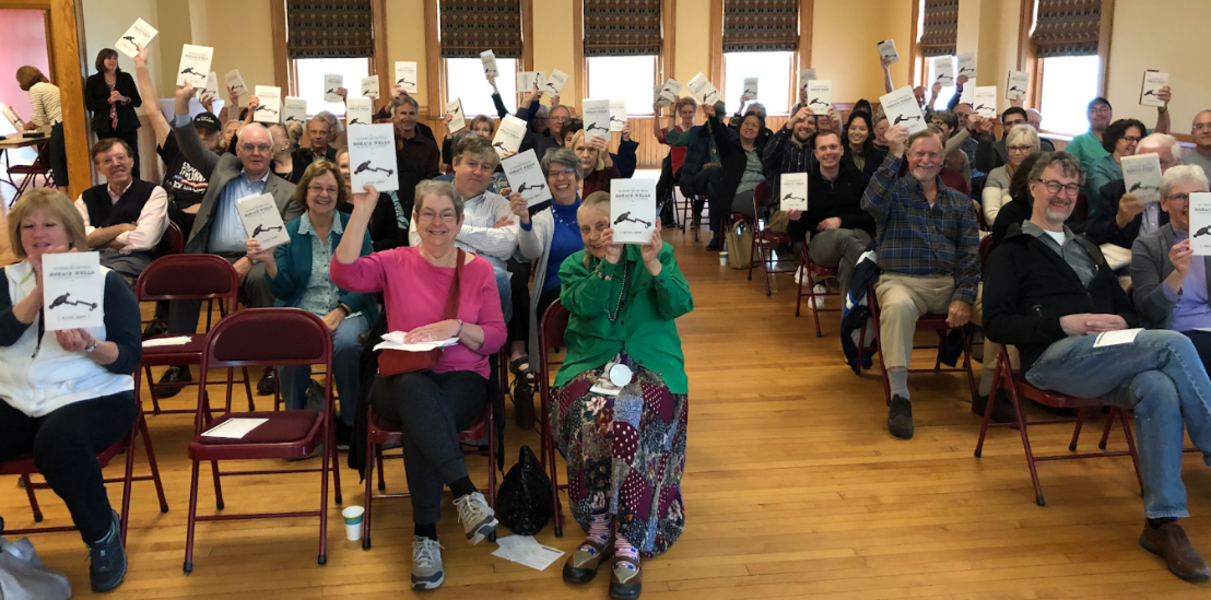 with readers of The Strange and True Tale of Horace Wells
with readers of The Strange and True Tale of Horace WellsA foundation invited me to Connecticut where Horace Wells lived to read from the book and answer questions from these lovely people.
-
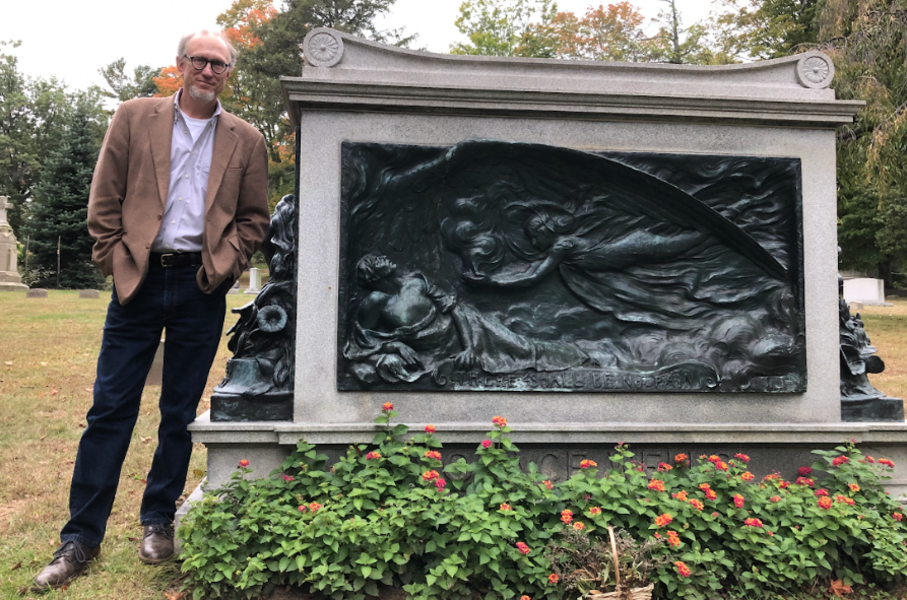 At the grave of Horace Wells and his family
At the grave of Horace Wells and his familyResearch is central to my work – even my fiction writing. That research includes books and the internet but goes far beyond those. For example, to better understand my subject in the Horace Wells novel, I spent time in Hartford, CT, visiting places where he lived and worked, examining his daybook and holding his death mask, and spending time at the Cedar Hill cemetery where he and his family are buried. I even asked my dentist, who needed to fill a cavity for me, if he would give me nitrous oxide, the gas that Horace Wells used to first experiment with anesthesia, so I could better understand its effects.
-
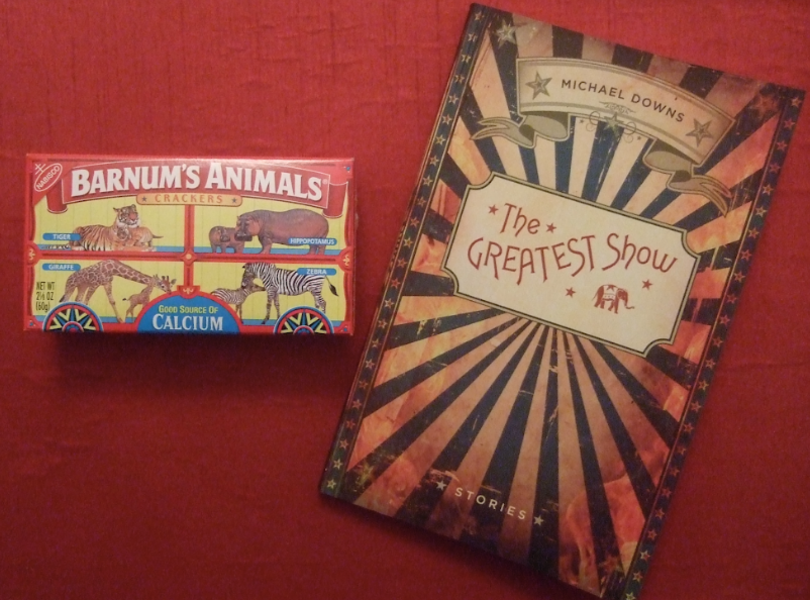 The Greatest Show: Stories
The Greatest Show: StoriesInspired by the true-life Hartford Circus Fire of 1944, this collection of ten linked stories explores the way disaster reshapes a community over decades. Stories from THE GREATEST SHOW appeared in The Georgia Review, The Missouri Review, the Kenyon Review, Gettysburg Review, and other journals. Three of the stories were recognized as distinguished in the Best American Short Stories series.
A finalist for the Paterson Prize in Fiction.
Foreword magazine: ''an auspicious fiction debut from a marvelously talented writer"
The Rumpus: "intricately woven"
Shenandoah Review: "beautifully written. Not a word out of place."
West Branch Wired: "These are quiet stories, in the tradition of Winesburg, Ohio, ... [with] the dramatic weight and complexity of a novel."
Colorado Review: "gorgeously captures the sweep of ordinary lives made remarkable by a tragic twist of fate."Available for Purchase -
Ania: a short story
This story, originally published in The Georgia Review, opens the collection, THE GREATEST SHOW. It tells the story of an immigrant housekeeper in Hartford, Connecticut, who steals tickets from her employer so she can take her son to the circus and who is therefore confronted with one of the worst fire disasters in American history.
"Ania" received recognition as notable in the Best American Short Stories series. It was the manuscript I entered when I won a literature fellowship from the National Endowment for the Arts.
-
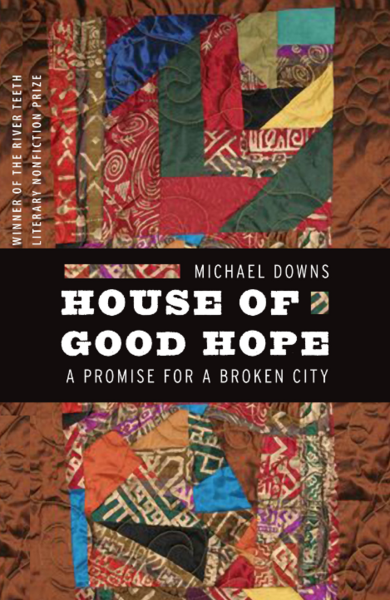 House of Good Hope: A Promise for a Broken City
House of Good Hope: A Promise for a Broken CityHOUSE OF GOOD HOPE: A PROMISE FOR A BROKEN CITY combines reportage and memoir to tells the true story of five remarkable and talented young men from Hartford, Connecticut, who pledge their lives to their hometown and who find that promise not always easy to keep.
Winner: River Teeth Prize for Literary Nonfiction
Finalist: Connecticut Book Award in Biography and Memoir.
The cover for HOUSE OF GOOD HOPE: A PROMISE FOR A BROKEN CITY, is detail from a quilt called "All that Amazing Jazz," by Hartford, Connecticut, quilt artist Ed Johnetta Miller. Photo by John Ryan.Available for Purchase -
excerpt: House of Good Hope
An excerpt featuring the opening pages of HOUSE OF GOOD HOPE.
"... a beautiful book, filled with the poignant bittersweet of hope and loss." – Buzz Bissinger, author of Friday Night Lights
Publishers Weekly: Combining a reporter's eye for detail, the breathless narrative rush of an action movie and the generous heart of a hometown boy desperately trying to make sense of a place gone terribly wrong, Downs examines the social and economic disintegration of Hartford, Conn., in the 1990s through the coming-of-age of five African-American teenage boys.
The Hartford Courant: "... a lavish love letter to Connecticut’s capital city." -
 Hollywood''s Team: a collaboration
Hollywood''s Team: a collaborationSelected by the Athletic sports journalism site as the one book to read about the Los Angeles Rams, HOLLYWOOD's TEAM is part history of Los Angeles, the NFL, and also part biography. It was a pleasure to assist author Jim Hock in his work to tell the story of his father, an offensive lineman who played for the Rams in the early 1950s.
"A winning new book..." – David Davis, LAObserved
Menckeniana: cultural criticism involving H.L. Mencken
My interest in the Sage of Baltimore, H.L. Mencken, confuses even me. I owe him nothing. I only started to read his work in the last few years. Though I've lived in Baltimore–his lifelong home as a columnist and editor for the Baltimore Sun–and though I've worked as a newspaper journalist, Mencken was not part of my life until 2021 when the Pratt Library invited me to give the annual Mencken Memorial Lecture.
Since then, I've continued my engagement with Mencken–once called the most powerful private person in the United States–by writing about him for both Baltimore Magazine and the Los Angeles Review of Books. What keeps me coming back to this iconoclast, admired for his skepticism and wit yet excoriated for racist and anti-Semitic writings? Maybe this. That to read Mencken is to wrestle with the United States and American culture–and not just as it was in the 1920s and '30s when Mencken was in his prime.
To wrestle with Mencken is to wrestle with the country and the culture as it is today.
-
Mencken Memorial Lecture, 2021
In 2021, when I gave the Mencken Memorial Lecture at the Enoch Pratt Free Library, it was to a nearly empty room: just a few friends in masks. But the lecture also went out to several hundred others who watched the video live-streamed on Facebook. In the talk, titled "The Babelobabuli: Notes on Mencken and Today's Muddled Topography of Literary Journals," I considered what Mencken suggests to us as readers and writers about navigating the thousands of literary journals published today online and in print. I quoted Mencken, saying that "good work is always done in the middle ground, between the theories," a line that explains our time when writers are more than ever working in a wide-open literary landscape, one that allows for the creation of new and exciting work.
The talk was later published as an essay in "Menckeniana: A magazine about all things Mencken."
The talk itself begins at the 2:30 mark in the video.
-
 Menckeniana cover
Menckeniana coverThe Fall 2022 issue of Menckeniana, No. 227, was the last to be published by the Enoch Pratt Free Library. It also included my essay, "The Babelobabuli," based on my talk given for the 2021 Mencken Memorial Day Lecture.
-
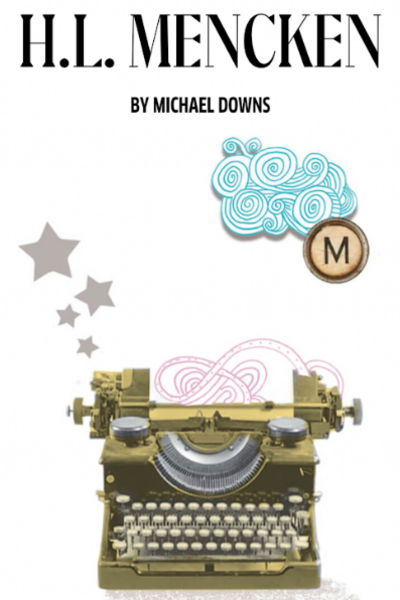 Baltimore Magazine and Mencken
Baltimore Magazine and MenckenBaltimore Magazine published "The City that Writes," short features on 13 dead Baltimore writers, written by 13 living ones. The magazine asked me to write about H.L. Mencken, the curmudgeonly Sage of Baltimore.
-
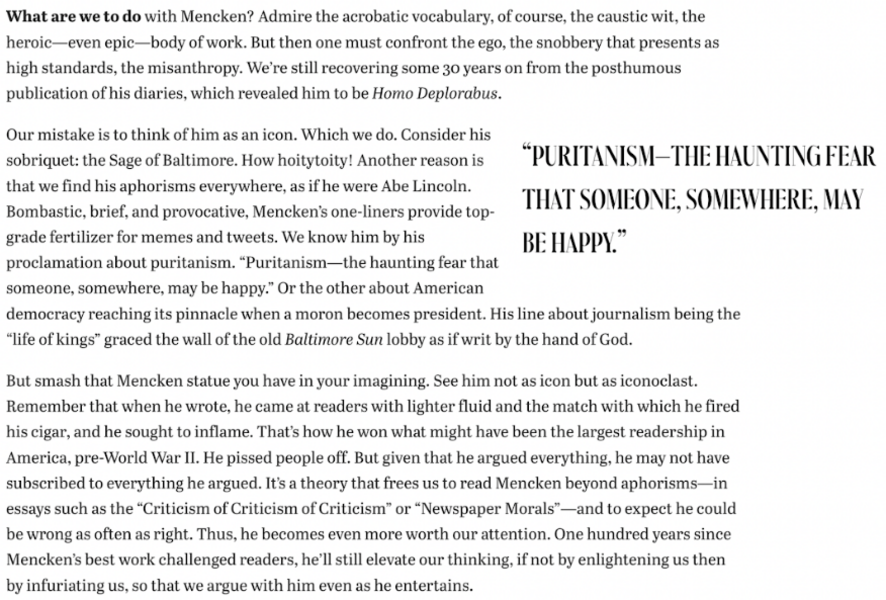 Baltimore magazine: What are we to do with Mencken?
Baltimore magazine: What are we to do with Mencken?"What are we to do with Mencken?" became the question that fueled my writing about him for Baltimore Magazine, and which continues to fuel my interest in H.L. Mencken, an important and controversial figure in his time and now.
-
 Los Angeles Review of Books
Los Angeles Review of BooksThe Los Angeles Review of Books is scheduled to publish my 3,700-word essay on Mencken on his birthday this year, January 29. "The Last of the Menckenians" considers the dwindling numbers of the Mencken Society and explores Mencken's value in today's literary culture.
From the essay:
"Aficionados don't read Mencken because they expect to agree with him. They read him for the adrenaline jolt. That jolt hits because Mencken delivers scorn with wit and reason. He vivifies his 21st-century fans as he has ever done for readers. 'He calls you a swine, and an imbecile,' wrote critic Walter Lippmann in 1926, 'and he increases your will to live.' "
Now She's Gone, I Don't Worry: A song biography of "Sitting on Top of the World"
"What kind of song is that?" asked Lonnie Chatmon, fiddler for the Mississippi Sheiks, that moment in 1929 after his partner, Walter Vinson, played him a tune he'd just written.
One answer? “Sitting on Top of the World,” first recorded in 1930 by the Sheiks, is a shapeshifter, having been performed or recorded hundreds of times in everything from jazz to bluegrass to Texas swing, folk, rock, and gospel. In that way it's a deeply American song, one that migrates across genres, regions, race, and meaning. What kind of song? One that for decades has held me with an inexplicable grip. One that led me to a literary memoir-essay in The Georgia Review, which in turn led me to my newest and ongoing book project: to write a song biography and tell the tale of this amazing, transcendent work of American art.
-
Essay: Trying to Find My Li'l All 'n' All (Georgia Review)
This essay, published in The Georgia Review, represents the start of my writing about "Sitting on Top of the World." In the essay, I embark on a road trip from Baltimore to Texas, mixing my need to learn about the song with my need to be a good son to my chronically ill mother and to my father, who is her primary caretaker.
"My parents, say my brother and sister, always wear their best faces when I visit. I'm the oldest, the prodigal who left home and never moved back. For me, Mom and Dad smile and straighten up. If not atop the world, they're resting on pillowed recliners. But I know. We all know."
I invite you also to read the essay online at the Georgia Review's website.
-
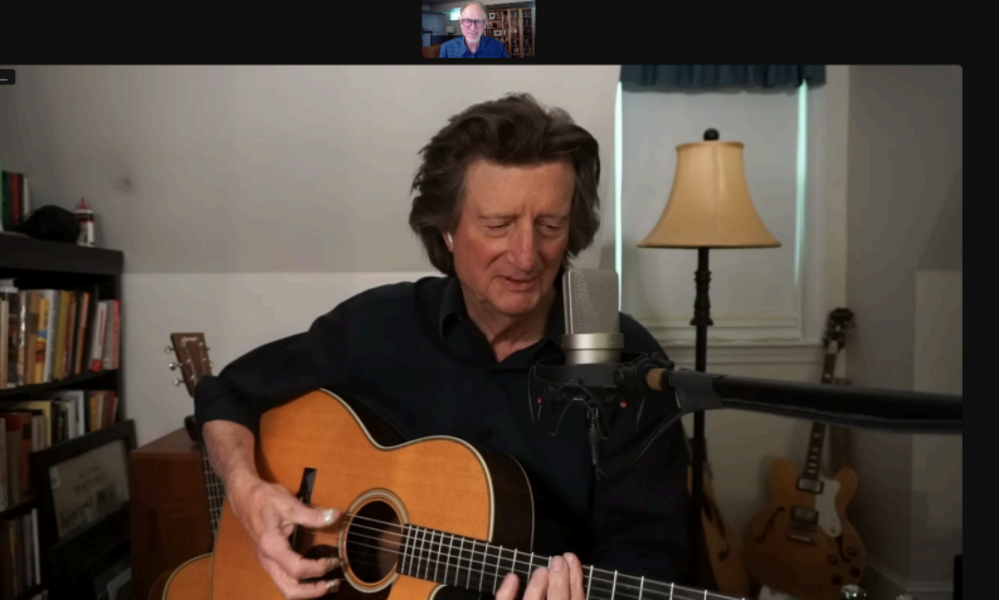 Sitting on Top of the World: performers
Sitting on Top of the World: performersThis song biography of "Sitting on Top of the World" requires research of all sorts, including journalistic. My journalism background–including as a newspaper reporter for more than a decade–has served me as I've worked on the book proposal. I've interviewed performers who have recorded versions of "Sitting on Top of the World." In this image from Zoom, I talk with singer-songwriter Chris Smither, who released a seminal version of the song in 1984 and then, in his 70s, recorded a more mature and complex version for his 2018 album, CALL ME LUCKY.
-
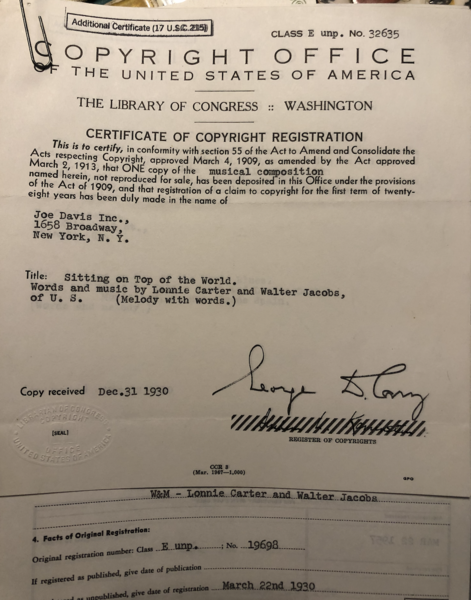 "Sitting on Top of the World": documents
"Sitting on Top of the World": documentsThis song biography requires me to do deep dives into documents. To complete the book proposal, I've read theses and dissertations about the blues and performers who have recorded "Sitting on Top of the World," listened to hours of audio from the 1972 Smithsonian Festival of American Folk Life, and–with assistance from a folklorist who worked with Walter Vinson, who wrote the song–dug into personal and professional documents pertaining to Vinson and the Mississippi Sheiks. This image shows a copyright sheet naming Walter Vinson and his partner Lonnie Chatmon as authors of the song. This documentation served in Walter Vinson's late-in-life battle to win back rights and royalties stolen from him when others claimed authorship of "Sitting on Top of the World."
-
 Playlist: Sitting on Top of the World
Playlist: Sitting on Top of the WorldPerformers have recorded hundreds of versions of "Sitting on Top of the World" in a variety of genres. I've collected more than 50 versions by performers who are famous or obscure, from the earliest days of recorded blues to soundtrack versions to go with contemporary TV shows. I invite you to listen to the variety and nuance of the recordings. Click this link to go to Spotify where I've curated a small collection of versions.


